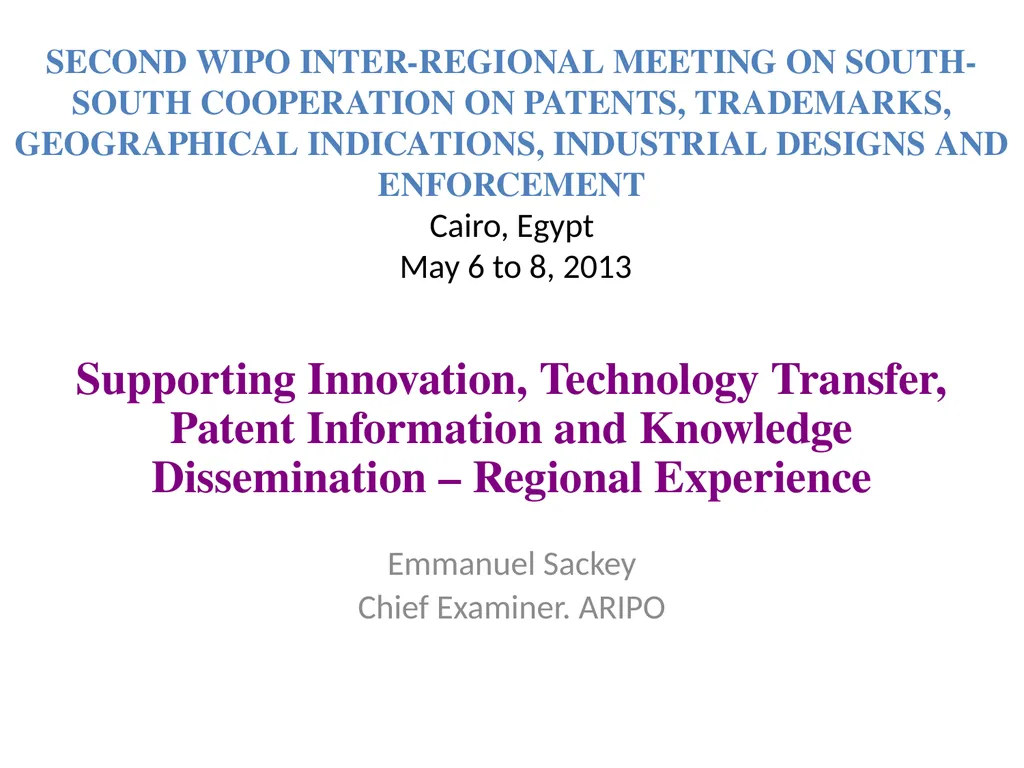SECOND WIPO INTER-REGIONAL MEETING ON SOUTH-SOUTH
Author : lois-ondreau | Published Date : 2025-05-09
Description: SECOND WIPO INTERREGIONAL MEETING ON SOUTHSOUTH COOPERATION ON PATENTS TRADEMARKS GEOGRAPHICAL INDICATIONS INDUSTRIAL DESIGNS AND ENFORCEMENT Cairo Egypt May 6 to 8 2013 Supporting Innovation Technology Transfer Patent Information
Presentation Embed Code
Download Presentation
Download
Presentation The PPT/PDF document
"SECOND WIPO INTER-REGIONAL MEETING ON SOUTH-SOUTH" is the property of its rightful owner.
Permission is granted to download and print the materials on this website for personal, non-commercial use only,
and to display it on your personal computer provided you do not modify the materials and that you retain all
copyright notices contained in the materials. By downloading content from our website, you accept the terms of
this agreement.
Transcript:SECOND WIPO INTER-REGIONAL MEETING ON SOUTH-SOUTH:
SECOND WIPO INTER-REGIONAL MEETING ON SOUTH-SOUTH COOPERATION ON PATENTS, TRADEMARKS, GEOGRAPHICAL INDICATIONS, INDUSTRIAL DESIGNS AND ENFORCEMENT Cairo, Egypt May 6 to 8, 2013 Supporting Innovation, Technology Transfer, Patent Information and Knowledge Dissemination – Regional Experience Emmanuel Sackey Chief Examiner. ARIPO Geographical Distribution of Member States of ARIPO Botswana Kenya Mozambique Somalia The Gambia Lesotho Sierra Leone Swaziland Tanzania Ghana Zimbabwe Malawi Zambia Uganda Sudan Namibia West Africa Central & Southern Africa East Africa Liberia Rwanda POTENTIAL MEMBER STATES OF ARIPO Seychelles South Africa Mauritius Nigeria Burundi Angola Ethiopia Eritrea STAFF AFFAIRS COMMITTEE ORGANS OF ARIPO Ministers responsible for IP matters – IP High Level Forum for Decision Making on Policy Issues; Administrative Council – Forum for IP Experts to determine development of IP; Committees and Board of Appeal – for specialized functions ; Secretariat – day to day operations of the Organization on IP matters. TECHNICAL COMMITTEE ARIPO LEGAL INSTRUMENTS LUSAKA AGREEMENT Adopted 1976 HARARE PROTOCOL Adopted 1982 BANJUL PROTOCOL Adopted 1993 NEW LEGISLATIVE DEVELOPMENTS SWAKOPMUND PROTOCOL Adopted in 2010 PROPOSED REGIONAL FRAMEWORK ON ABS PROPOSED REGIONAL PROTOCOL ON PLANT VARIETY PROTECTION The Main Objectives of The Harare Protocol Promote, Harmonize & Develop Industrial Property in the Member States of ARIPO; Facilitate the protection and administration of Patents, Industrial Designs and Utility Models in the Contracting States; ARIPO Patents, Industrial Designs & Utility Models are equivalent to a bundle of national registrations and their administration is centralized and made easier; Only one Grant, one publication, one agent is needed and Centralized procedures like: renewal, amendments, representation, etc. Advantages of the Harare Protocol to the National IP Offices The Protocol ensures that IP offices handle more applications and therefore receive more revenue that would otherwise be the case IP Offices save some of the costs of processing applications, particularly publication and grant/registration and renewals since this is done at the ARIPO Office on their behalf The quality of examination, particularly with regards to patents ensures that the rights granted have a strong presumption of validity IP Offices with weak infrastructure and limited human and financial resources still offer high standard of protection SUPPORTING INNOVATION AND ENHANCING THE INDUSTRIAL PROPERTY SYSTEM AT ARIPO Establishment of Masters in IP at the African University in Mutare, Zimbabwe (trained over 140 graduates). Planning to start MIP programmes in Tanzania (2014), Ghana (2015) Possibility to establish certificate and diploma programmes for MSMEs Enhancement of ICT infrastructure














